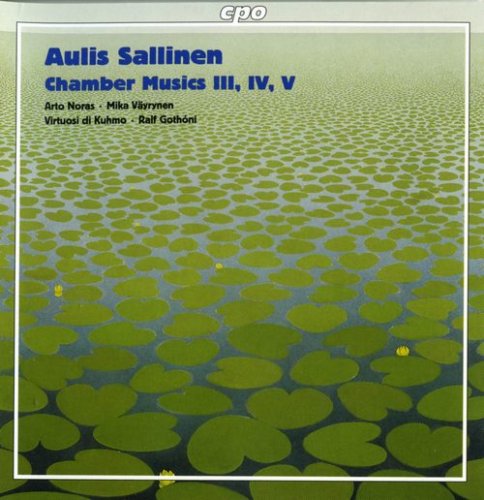
Ralf Gothoni, Arto Noras, Mika Vayrynen, Virtuosi di Kuhmo - Sallinen: Chamber Music (2006)
BAND/ARTIST: Ralf Gothoni, Arto Noras, Mika Vayrynen, Virtuosi di Kuhmo
- Title: Sallinen: Chamber Music
- Year Of Release: 2006
- Label: CPO
- Genre: Classical
- Quality: FLAC (tracks)
- Total Time: 01:13:08
- Total Size: 349 Mb
- WebSite: Album Preview
Tracklist:
01. Introduction and Tango Overture, Op. 74b 10:14
02. Chamber Music III, Op. 58, "The Nocturnal Dances of Don Juanquijote" 20:06
03. Elegy for Sebastian Knight, Op. 10 4:25
04. Chamber Music IV, Op. 79, "Metamophoses of Elegy for Sebastian Knight" 16:57
05. Chamber Music V, Op. 80, "Barabbas Variations" 20:57
Performers:
Gothoni, Ralf - piano
Noras, Arto - cello
Vayrynen, Mika - accordion
Virtuosi di Kuhmo - Ensemble
Gothoni, Ralf - Conductor
01. Introduction and Tango Overture, Op. 74b 10:14
02. Chamber Music III, Op. 58, "The Nocturnal Dances of Don Juanquijote" 20:06
03. Elegy for Sebastian Knight, Op. 10 4:25
04. Chamber Music IV, Op. 79, "Metamophoses of Elegy for Sebastian Knight" 16:57
05. Chamber Music V, Op. 80, "Barabbas Variations" 20:57
Performers:
Gothoni, Ralf - piano
Noras, Arto - cello
Vayrynen, Mika - accordion
Virtuosi di Kuhmo - Ensemble
Gothoni, Ralf - Conductor
From the face of it, Aulis Sallinen's interest in composing chamber music drops off precipitously in the mid-'80s as his symphonies and operas began to take hold in the international market. This would be a pity if it were entirely true, as it was through the chamber music medium that Sallinen made his initial reputation through such masterpieces as the String Quartets No. 3 ("Some Aspects of Peltoniemi Hintrik's Funeral March"), No. 4 ("Quiet Songs"), and the cello solo Elegy for Sebastian Knight. CPO's Aulis Sallinen: Chamber Musics III, IV, V, performed by members of the Virtuosi di Kuhmo under the general direction of pianist Ralf Gothóni, makes clear that Sallinen's later chamber music is not so much absent as it is in hiding, disguised as concertante works for soloist and string orchestra. The tango is as endemic to Finland as it is to Argentina; when Frank Zappa played Helsinki in 1974, he added Satumaa, the national Finnish tango, to his band book in order to surprise the audience. Tango strongly influences the sound of the first two pieces here, the Introduction and Tango Overture, Op. 74b (1997), in which Gothóni plays a pivotal role as soloist, and The Nocturnal Dances of Don Juanquijote (1986) that doubles as Sallinen's Chamber Music III, Op. 58. It's a highly entertaining piece, with snatches of popularly oriented tango stretched out by more nebulous material; at one point Sallinen restates his tango in 5/4 time -- it is both zany at times and serious at others. Arto Noras is cellist in this and in the classic Elegy for Sebastian Knight (1964), included as it proves the basis for Chamber Music IV Op. 76 ("Metamorphoses of Elegy for Sebastian Knight") (2000). In the later work, the piano takes up the first three notes of the earlier Elegy and subjects it to a number of transformations that are picked up by the string group, and shortly we find we are in the midst of yet another tango-like phrase. Whereas in the original Elegy for Sebastian Knight, serial-styled cellular motifs are used to break out of serially derived habits of composition, in the "Metamorphoses of Elegy for Sebastian Knight" the same motifs are used to add some aspect of serial-sounding elements into a structure that is primarily tonal -- interesting.
The program concludes with Sallinen's Chamber Music V Op. 80, ("Barabbas Variations for accordion and strings") (2000), with the solo accordion part played with spirit and verve by Mika Väyrynen. While the subtitle provides a clue that this work has some relationship to Sallinen's chamber cantata Barabbas Dialogues; however, that work was completed somewhat later than this one. "Barabbas Variations" is also shot through with liberal references to the tango, and the piece is one of the longest works in the literature to feature the accordion this side of Astor Piazzolla; virtuoso accordion players should take note. Sallinen's approach to the tango is certainly frostier than that of Osvaldo Golijov -- after all, Finland is a much colder place than Argentina. However, utilizing Sallinen's interests in this medium to drive a program of chamber pieces spanning 40 years is certainly a novel idea, and in CPO's Aulis Sallinen: Chamber Musics III, IV, V a highly successful one.
The program concludes with Sallinen's Chamber Music V Op. 80, ("Barabbas Variations for accordion and strings") (2000), with the solo accordion part played with spirit and verve by Mika Väyrynen. While the subtitle provides a clue that this work has some relationship to Sallinen's chamber cantata Barabbas Dialogues; however, that work was completed somewhat later than this one. "Barabbas Variations" is also shot through with liberal references to the tango, and the piece is one of the longest works in the literature to feature the accordion this side of Astor Piazzolla; virtuoso accordion players should take note. Sallinen's approach to the tango is certainly frostier than that of Osvaldo Golijov -- after all, Finland is a much colder place than Argentina. However, utilizing Sallinen's interests in this medium to drive a program of chamber pieces spanning 40 years is certainly a novel idea, and in CPO's Aulis Sallinen: Chamber Musics III, IV, V a highly successful one.
As a ISRA.CLOUD's PREMIUM member you will have the following benefits:
- Unlimited high speed downloads
- Download directly without waiting time
- Unlimited parallel downloads
- Support for download accelerators
- No advertising
- Resume broken downloads


